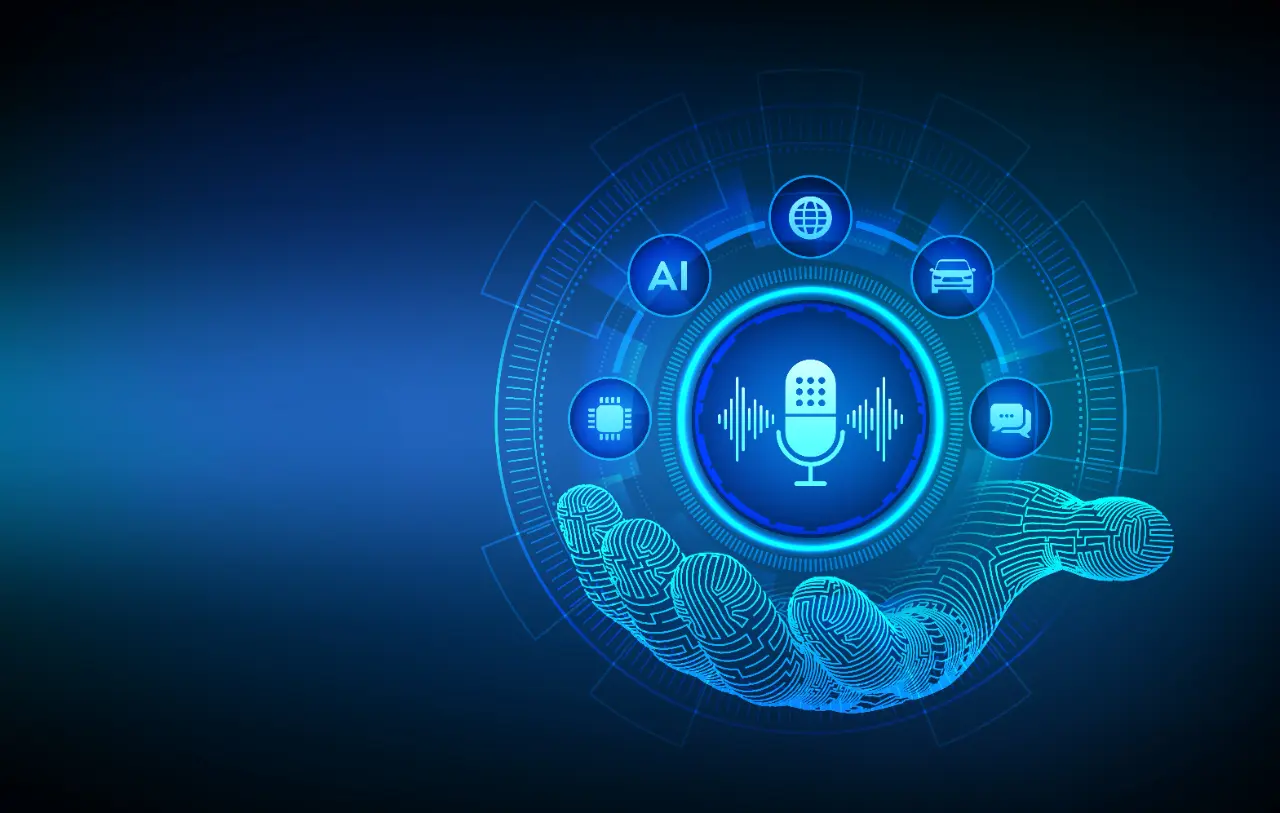AI agents are no longer just futuristic concepts instead, they have become today’s productivity powerhouses. From automating repetitive tasks to handling customer conversations around the clock, these intelligent systems are transforming how we work, communicate, and scale. Whether you’re a student, small startup or business leader, building your own AI agent is now more accessible than ever, often without writing a single line of code.
According to a 2024 report by McKinsey, businesses that deploy AI agents across customer service and operations see a 20–40% reduction in response times and up to 35% cost savings. Meanwhile, Google Trends shows a 300% surge in global searches for “build AI agent” over the past 12 months, signalling a massive shift in interest from tech professionals. The rise of no-code tools and platforms like SquadStack is making this technology scalable for all.
In this beginner-friendly guide, you’ll learn how to build your own AI agent, step by step. We’ll cover what an AI agent is, why it’s valuable, real-world use cases, common pitfalls to avoid, and how SquadStack’s AI Agent platform makes the process simpler, faster, and scalable. Whether you want to automate support, qualify leads, or just experiment, this guide will help you get started confidently.
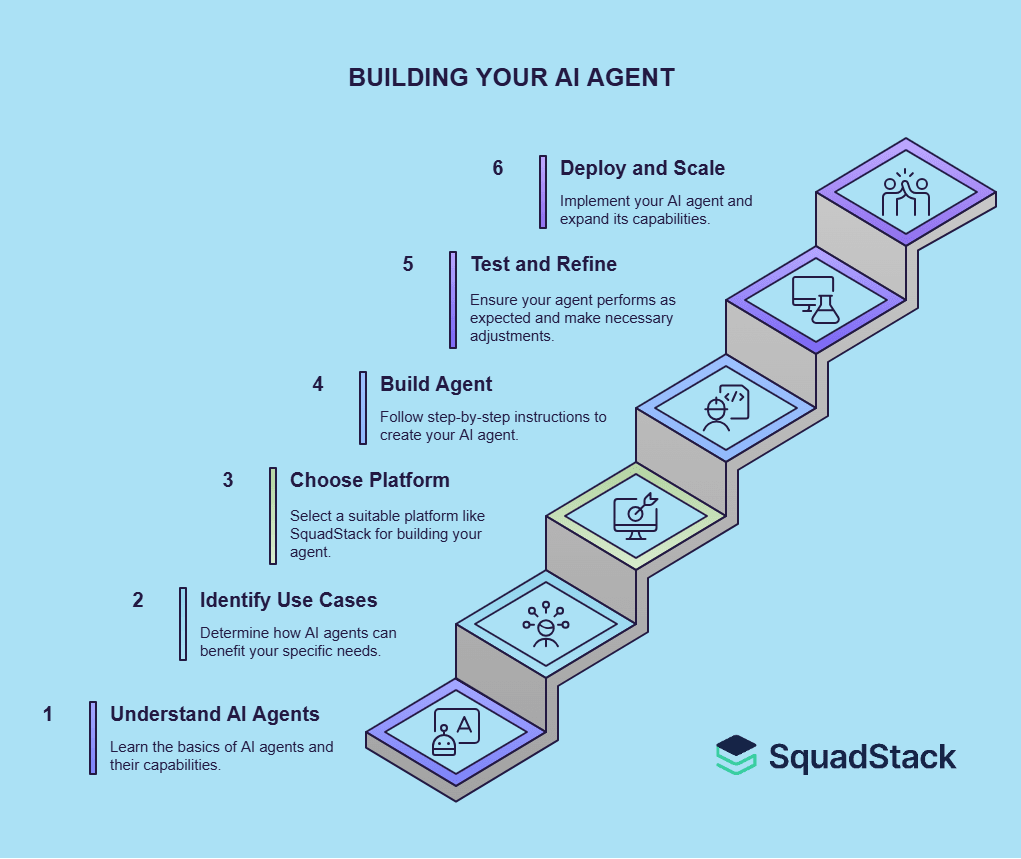

What Is an AI Agent?
An AI agent is a digital system designed to understand tasks, make decisions, and act independently based on the data it receives. Think of it as a smart assistant that doesn't just follow fixed commands, but learns, adapts, and interacts intelligently. Unlike traditional rule-based bots, AI agents use technologies like natural language processing (NLP), machine learning, and sometimes even memory-based reasoning to simulate human-like decision-making. This makes them capable of holding conversations, solving problems, and even improving over time through training and feedback.
For example, a customer service AI agent can understand a query like “I need help with my refund,” check order data, generate a relevant response, and follow up all without human intervention. Some AI agents even speak regional languages or handle voice-based calls, like those built with SquadStack’s AI Agent platform.
In simple terms, an AI agent is more than a chatbot; it's a self-directed digital worker that performs tasks intelligently. You can deploy it across websites, mobile apps, call centres, and internal workflows to automate repetitive jobs and scale customer interactions without adding human overhead.
Why Build One: Benefits and Key Components Explained
Creating your own AI agent isn’t just for tech enthusiasts anymore; now it’s becoming a practical, profitable move for beginners, startups, and enterprises. From handling routine queries to personalising user experiences, AI agents offer capabilities that scale effortlessly. As businesses face growing pressure to operate efficiently, building a custom AI agent is emerging as a must-have solution. This section explores both why building an AI agent is worth your time and what powers one under the hood.
Key Benefits of Building Your Own AI Agent
AI agents are designed to make life easier by automating repetitive work and enhancing digital experiences. Whether you’re running a solo operation or managing a support team, the benefits of deploying your own AI agent are immediate and measurable.
- 24/7 Automation Without Burnout
Unlike human agents, AI agents can run 24/7 without breaks or human error. They respond instantly, reducing wait times and improving customer satisfaction. This is especially useful for handling off-hours requests or serving global audiences. - Massive Cost Savings
Deploying an AI agent drastically cuts operational expenses. A 2024 Deloitte report found that businesses leveraging AI-driven automation saved between 25% and 45% in support costs. By reducing dependence on large support teams, you can reinvest that capital elsewhere. - Personalised User Interactions at Scale
AI agents can remember customer preferences, previous chats, and interaction history. This enables highly personalised conversations. - Faster Response Times and Lead Handling
With AI agents, queries are handled in real-time. Leads are captured, qualified, and routed instantly, ensuring no opportunity slips through the cracks. This is especially useful for high-volume inbound channels.
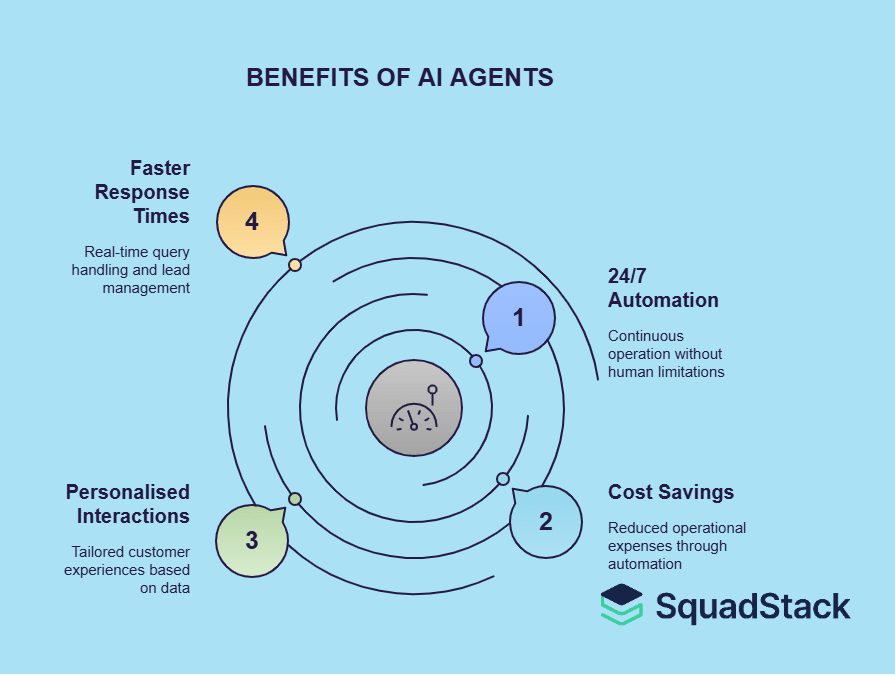
Key Components of a High-Performing AI Agent
To build your own AI agent successfully, you need to understand what goes into it. Think of an AI agent like a digital brain, and it needs language skills, memory, logic, and the ability to act on its own. In this section, we’ll break down each core part that makes these agents intelligent and useful.
- Natural Language Processing (NLP)
This is the engine that helps your AI agent understand and generate human language. With NLP, your agent can comprehend queries like “Where’s my refund?” or “I need a quote.” Modern platforms use large language models like GPT-4 to handle nuance, intent, and even regional slang effectively. - Contextual Memory and Learning
Good AI agents don’t just respond, but they remember. Memory allows them to track previous conversations, recall names, understand preferences, or continue multi-step tasks. This leads to smoother, more human-like interactions. - APIs and Integration Layer
For an AI agent to be useful, it must connect with your existing systems. Integrations with CRMs, support desks, payment systems, or scheduling tools allow it to complete end-to-end tasks without human involvement.
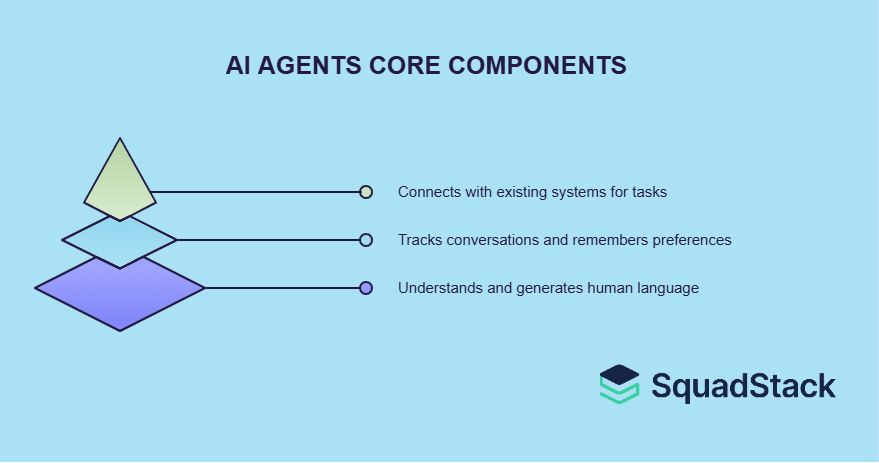
Step-by-Step Guide to Build Your Own AI Agent
Building your own AI agent might sound intimidating, but today’s tools make it surprisingly easy, even if you don’t have a technical background. Whether you want a chatbot, voice bot, or a multi-purpose virtual assistant, this step-by-step guide will walk you through the essentials. From defining your goal to going live, each step brings you closer to creating an intelligent, self-operating digital assistant. Let’s get started on how to build your own AI agent that works for your business or personal project.
Step 1: Define the Purpose and Use Case
Before anything else, ask yourself what problem your AI agent solves. The more specific your use case, the easier it will be to design and train your agent effectively.
For example, is it going to answer FAQs, qualify leads, schedule meetings, or handle support tickets? Clearly defining the task helps set the scope, the tone of responses, and the kind of data your agent will need.
Step 2: Choose the Right AI Platform or Tool
Your choice of platform determines what you can build and how easy it will be. If you're a beginner, go for no-code or low-code AI agent builders like SquadStack, Dialogflow, or Botpress.
Platforms like SquadStack’s AI Agent are designed for voice and call centre automation, while others like ChatGPT or Intercom focus on text-based interactions. Look for platforms that offer pre-built workflows, NLP capabilities, and integration support for tools like CRMs and ticketing systems.
Step 3: Design Conversation Flows or Task Logic
Now it’s time to define how your agent will interact. Create a basic flow of user questions and expected responses, using decision trees or intent-based logic.
Use a visual builder if your platform supports it. Add variations of questions users may ask and map them to accurate, helpful replies. If your agent will perform actions, like checking order status or booking slots, define those flows too. This logic is the brain of your agent.
Step 4: Train Your AI Agent with Sample Data
To improve understanding and response accuracy, you’ll need to train your agent with real-world data. This could be historical chat transcripts, support tickets, or customer queries.
The more data you give, the better it gets. Training your agent helps it understand context, slang, tone, and even emotional cues. Don’t forget to test different edge cases and tricky questions your audience might ask.
Step 5: Integrate with Other Systems (CRM, Email, etc.)
Integrations enable the AI to fetch or update data, send reminders, file support tickets, and even trigger backend processes. Without this, your agent remains a glorified chatbot. Choose a platform that supports easy plug-ins or API connections.
Step 6: Test and Refine the Agent Interactions
Before going live, thoroughly test your AI agent. Simulate real conversations, try edge cases, and ask unexpected questions to check how it handles them.
Look out for awkward phrasing, missed intents, or repetitive loops. Gather feedback from a small user group and iterate. Testing ensures your agent is reliable, helpful, and ready for a wider audience.
Step 7: Deploy and Monitor Performance Regularly
Once your agent is ready, it’s time to go live. Deploy it across your chosen channels, such as websites, mobile apps, voice systems, or contact centres. Make sure your users know how to access it.
After deployment, monitor key metrics like response time, resolution rate, user satisfaction, and fallback frequency. Most platforms (like SquadStack) offer dashboards and insights so you can improve your agent continually based on data.
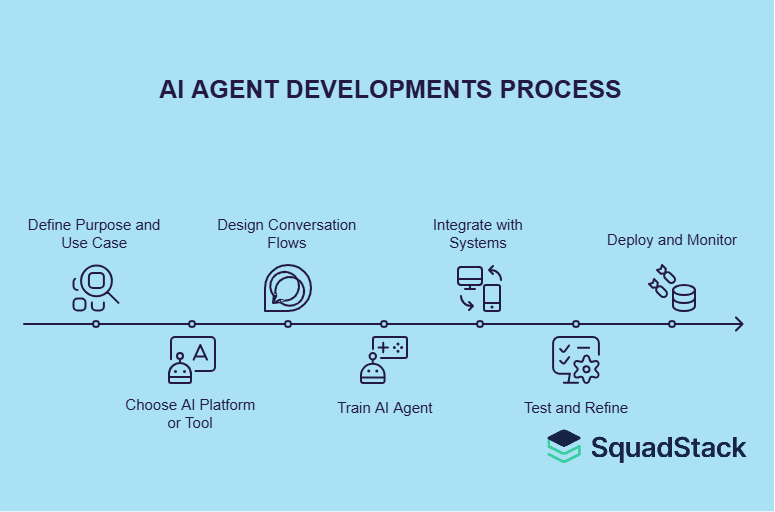
Top Use Cases for AI Agents
AI agents are reshaping industries by automating interactions, reducing costs, and boosting efficiency across departments. Whether you're in e-commerce, healthcare, real estate, or education, you can build your own AI agent tailored to your unique business needs. These agents can manage voice calls, chats, emails, and even backend tasks, freeing up humans to focus on what is more important. In this section, we’ll explore the most common (and powerful) real-world applications of AI agents in 2025.
Customer Support Automation
Customer support is one of the most impactful areas where AI agents shine. They help companies scale service, reduce costs, and provide faster, round-the-clock support and all while improving user satisfaction. AI agents can handle 80% of routine queries like order tracking, refunds, FAQs, and password resets. They understand natural language, detect sentiment, and even escalate complex cases to human agents when needed. By integrating with CRMs, they pull customer history in real time, resulting in smarter, more personalised resolutions.
Lead Qualification and Appointment Scheduling
Sales teams lose hours every week chasing unqualified leads or managing calendar bookings. With AI automation, that entire process can be streamlined effortlessly. AI agents can engage visitors, ask qualifying questions, and instantly route high-quality leads to sales reps. For example, a real estate agent bot can ask, “Are you looking to buy or rent?” and suggest matching properties or schedule tours. This saves time, reduces drop-offs, and boosts conversion rates across the funnel.
Call Centre & Voice Support Automation
Contact centres are now replacing traditional IVRs with conversational AI agents that can speak naturally with callers, making the experience smoother and less frustrating. Voice-based AI agents, like those powered by SquadStack, handle high volumes of calls in local languages, understand context, and process requests like “check my claim status” or “reschedule delivery.” This allows call centres to scale without hiring more agents, especially during seasonal spikes.
Education & Learning Assistants
AI agents in edtech are acting as personalised tutors, answering student queries, helping with assignments, or recommending resources based on performance data. A virtual learning agent can explain concepts, offer practice problems, and track student progress over time. With multilingual and voice support, these agents also help bridge access gaps in Tier 2/3 cities where quality human instruction is limited.
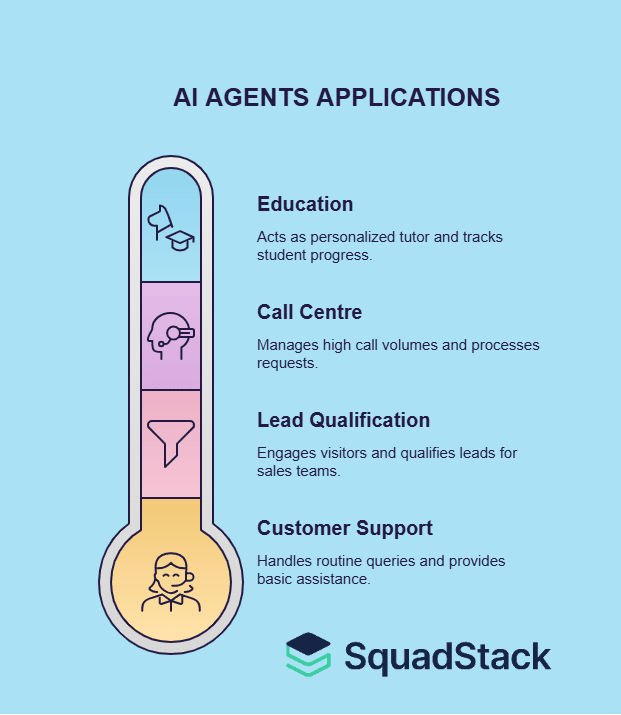
Why Choose SquadStack to Build Your AI Agent
While there are many platforms to build your own AI agent, SquadStack stands out with its specialised focus on voice AI, high-volume automation, and India-centric intelligence. Whether you're building a customer support bot, a sales follow-up agent, or a voice-driven lead qualifier, SquadStack offers tools, training, and tech to launch faster and scale confidently. With millions of real conversations powering its models, SquadStack delivers both accuracy and adaptability.
Trained on Real Insurance, Finance & Ecommerce Conversations
One of SquadStack’s biggest advantages is its vast dataset. The platform is trained on millions of real call recordings across sectors like motor insurance, lending, retail, and education. This industry-specific training gives SquadStack agents a clear edge; they understand customer behaviour, domain lingo, and regional variations. That means your agent can sound natural and competent, even in complex Tier 2 or Tier 3 conversations.
Voice-First Infrastructure Built for Contact Centres
While most platforms focus only on chatbots, SquadStack was built from the ground up for voice-based AI automation in real-world call centres. Their AI agents handle calls with human-like fluency, detect customer emotions, and navigate dialogues dynamically, without sticking to rigid scripts. This is game-changing for businesses that rely on inbound or outbound voice communication to engage customers.
Enterprise-Grade Compliance and Security
Data security and user trust are critical when deploying AI agents. SquadStack ensures enterprise-grade safeguards through encryption, role-based access, and compliance with India’s DPDP Act and other global standards. This makes it suitable for sectors like finance, healthcare, or edtech, where customer data is sensitive and security lapses are costly. You get speed and safety.







